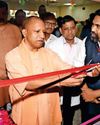試す 金 - 無料
ALL OF US ARE DESCENDANTS OF THE HARAPPANS
THE WEEK India
|December 29, 2024
Vasant Shinde led the excavation of Rakhigarhi (Haryana) and co-authored two landmark papers published in Cell and Science, in 2019, based on the DNA analysis of a 4,500-year-old female skeleton recovered from the site. The study grabbed eyeballs as it provided the first genetic insights into our ancestry, and the findings were included in NCERT textbooks.

However, it also sparked a debate, with some scholars being divided over the interpretation of the data, especially in relation to the contentious Aryan invasion or migration theory.
Shinde, who also served as the vice-chancellor of Deccan College, is overseeing the establishment of a national maritime museum in Lothal, a massive project expected to open within a year. In an interview with THE WEEK, Shinde spoke about the significance of Rakhigarhi, its most famous woman and addressed lingering doubts about the findings. Excerpts:
Why is Rakhigarhi so important?
There was no clear idea about the size of Rakhigarhi before our excavations. The site is spread over 500 hectares, which is double the size of the biggest known Harappan city of Mohenjo-daro. [With Rakhigarhi] we now know that the beginning of the Harappan culture goes back to 6000 BCE. This is important because we did not have such early dates before.
What answers did Rakhigarhi provide?
We found good evidence of the gradual growth of the Harappan city.... In the case of architecture, we found that they began with simple, circular pit dwellings. Four or five dwellings formed a cluster. So each one used for a different purpose, be it for sleeping, as a kitchen or for storage. This is how they started in 6000 ВСЕ.
In the next level, maybe in around 5500 BCE, they continued to build circular huts but not underground. Then in the third phase, we find proper rectangular Harappan structures. In the fourth stage, there is some modicum of planning as structures are arranged in a linear pattern, and roads and streets started coming up. In the fifth phase,full-fledged townships emerge.
How did the process of DNA extraction happen?
このストーリーは、THE WEEK India の December 29, 2024 版からのものです。
Magzter GOLD を購読すると、厳選された何千ものプレミアム記事や、10,000 以上の雑誌や新聞にアクセスできます。
すでに購読者ですか? サインイン
THE WEEK India からのその他のストーリー

THE WEEK India
AI ALONE WON'T HEAL INDIA'S HEALTH CARE
India needs a mission-driven, public-first approach in using AI for health, not a race to mimic the west
4 mins
November 23, 2025

THE WEEK India
A Lifeline of Hope Compassionate Revolution ft. Sushena Health Foundation
In a world often focused on metrics and outcomes, a quiet but profound revolution based on compassion and equitable access is being envisioned.
2 mins
November 23, 2025

THE WEEK India
Precision is the New Default Why Robotic Surgery Has Become the Mainstream
In a world where our phones unlock with a glance and our cars can drive themselves, it would be unfair if the operation theatre remained trapped in yesterday's technology. Surgery today is about purposeful precision with every movement measured, every outcome intentional. The evolution of robotic surgery represents this very shift — from ‘good enough’ outcomes to outcomes that are consistently excellent and predictable.
1 mins
November 23, 2025

THE WEEK India
New kids on the stage
For these next-gen actors, theatre holds as much appeal as stardom in cinema
5 mins
November 23, 2025

THE WEEK India
Precision Driven IVUS-NIRS Technology is Transforming Cardiac Care
Dr Balbir Singh, Chairman and Head of Cardiology at Max Healthcare, is a recipient of numerous prestigious honours, including the Padma Shri, for his exceptional skills and contributions in interventional cardiology and electrophysiology. Dr Singh has performed thousands of Intra-Vascular Ultrasound (IVUS) driven Angioplasties. IVUS is used in angioplasty to provide doctors with a detailed, real-time, three-dimensional view of the artery's interior, which helps them to precisely assess blockages, guide stent placement, and confirm the success of the procedure.
3 mins
November 23, 2025

THE WEEK India
White Spot Lesions in Dentistry
White spot lesions (WSLs) are the earliest visible signs of dental caries, appearing as chalky white or opaque areas on tooth surfaces. They indicate early enamel demineralization and can be seen with the naked eye. Early recognition and management are essential to prevent progression into cavities.
1 mins
November 23, 2025
THE WEEK India
The New Age of Spine Surgery
Taking care of your spine begins with small, consistent habits. Maintaining correct posture while sitting or lifting, walking regularly, and strengthening back and core muscles can go a long way in preventing problems. Eating a balanced diet and keeping body weight under control also help reduce stress on the spine.
1 min
November 23, 2025

THE WEEK India
THE RED FLAG IN YOUR URINE: Understanding and Detecting Bladder Cancer
The bladder is an organ which stores urine, which is produced by the kidneys. The bladder is a hollow, viscus organ that holds it for a few hours before it is eliminated. While it can occur at any age, the median age of diagnosis is typically 70 years or older.
1 mins
November 23, 2025

THE WEEK India
INTERNATIONAL QUALITY HEALTHCARE MADE AFFORDABLE IN VELLORE
Naruvi Hospitals, creating new benchmarks in affordable world class health care, spreading its ‘Fragrance of Care’ in Vellore, and beyond.
4 mins
November 23, 2025

THE WEEK India
Richardsons Face Hospital
India's first face hospital
1 mins
November 23, 2025
Listen
Translate
Change font size
